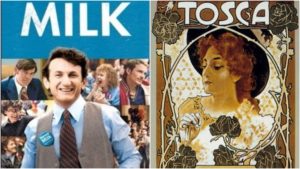
Opera Meets Film: Harvey Milk As a 20th Century ‘Tosca’
By David Salazar“Opera Meets Film” is a feature dedicated to exploring the way that opera has been employed in cinema. We will select a section or a film in its entirety, highlighting the impact that utilizing the operatic form or sections from an opera can alter our perception of a film that we are viewing. This week’s installment takes a look at Gus Van Sant’s “Milk.”
Puccini’s “Tosca” only shows up a few times in “Milk,” but its appearances are significant, building a connection between the film’s tragic hero and the opera’s tragic heroine.
The film draws the connection in a number of ways that we will get to, but the most obvious one takes place right during the epilogue of the film. After winning the Proposition 6 vote, Milk heads to the opera. We watch the final scene of “Tosca,” the death of the heroine given prominence. Then just minutes later, after being shot, he looks out the window. Staring back at him is the San Francisco Opera House with banners of “Tosca.”
It is at this moment that Van Sant makes it clear that his intention all along has been to link the film’s eponymous character with that of the operatic figure. And it is with this sequence of shots that the parallels between the two become clear.
Milk constantly talks about politics being theater for him and when he arrives in City Hall, he notes that it is his new “theater.” Tosca, of course, is a soprano in the opera and constantly remarks on her singing engagements. We even get a chance to hear one.
But their conflicts are also rather closely linked. Milk and Tosca are both battling corrupt political machines. Milk’s battle is initially with the local police, then local politicians, and eventually, a nationwide movement against gay rights. Tosca’s battle is on a more personal level as she is tasked to preserve her dignity in the face of a corrupt police officer looking to sexually abuse of her (no doubt that the two would find themselves rather identified with today’s sociopolitical landscape).
Of course, both Tosca and Milk manage to win their respective battles. Tosca by murdering Scarpia and Milk through collective effort of the masses and strength of leadership.
But neither gets to enjoy their respective victories. Milk is assassinated and Tosca commits suicide after seeing her lover executed.
The music that appears throughout the film plays up the connections in different manners as well.
We hear an excerpt at the start of the film that plays into Milk building his movement. It plants the seed of the opera’s appearance in the movie.
The second appearance takes place nearly halfway through when Scott, Milk’s lover is leaving him. We hear “E lucevan le stelle” over the moment, emphasizing the pain of losing Milk’s lover. A few scenes later, the love duet makes an appearance as Milk gets ready for his next run at the election. The music eventually comes to an end when Milk meets his new lover Jack. The opera serves as a connection between his two romances.
But it doesn’t end there. After seeing the performance live, Milk calls Scott up to tell him about his evening at the opera and Scott asks him to take him the next time he goes to see a show. Opera is once again connecting him back to his lover, emphasizing Puccini’s score as a leitmotif for Milk’s romantic relationships.
The fact that it is “Tosca,” a tragedy, only emphasizes what Milk ultimately loses out on.


